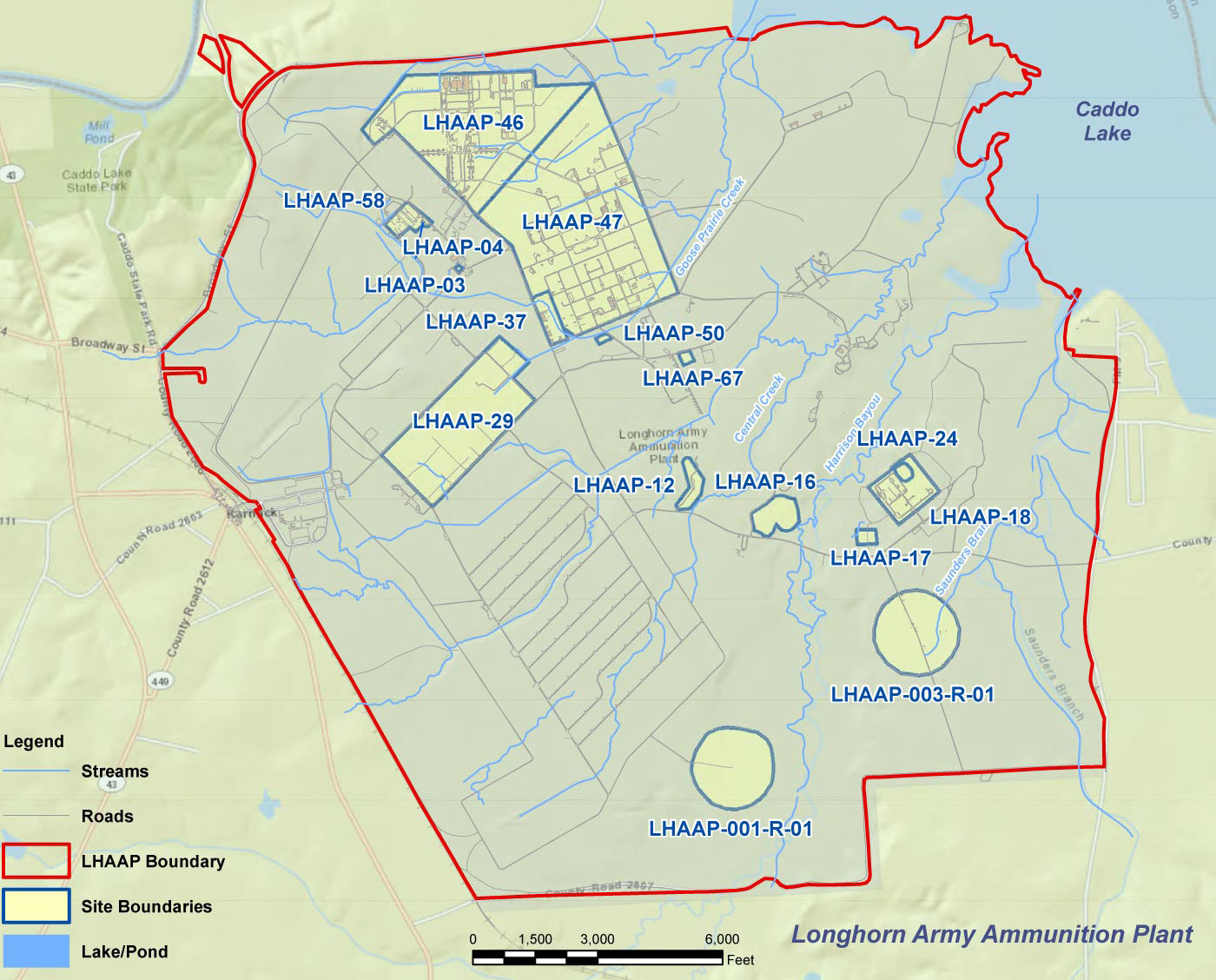Longhorn Army Ammunition Plant
Environmental Restoration Program
LHAAP-29
Site Description/History
LHAAP-29, also known as the Former TNT Production Area is an 85-acre site located within a heavily wooded section in the western-central portion of LHAAP. Remaining features of former facilities at LHAAP-29 include the foundations for the former production facilities and the underground pipelines that were originally built for cooling water drainage and TNT wastewater conveyance.
LHAAP-29 was used as a TNT manufacturing facility from October 1942 to August 1945. The facility produced approximately 400 million pounds of flake TNT during its operation using six TNT production lines (five active and one standby). The TNT production facility was inactive from August 1945 to 1959. In 1959, most of the buildings and aboveground storage tanks were removed. The debris was burned or flashed at Burning Ground No. 2 / Flashing Area ( LHAAP-17). Concrete foundations, open-top concrete-lined pits, most of the underground utilities, and a network of underground pipelines still remain at the site. Since the end of World War II, the only activity that has been documented to have occurred at LHAAP-29 is the “soak out” or solvent bath of out-of-specification rocket motors. This took place from 1959 to the mid-1970s and involved the use of methylene chloride-based industrial solvent at tank 801-F. Waste from this operation was sent to LHAAP-18/24.
Remediation Activities
Several investigations to determine the nature and extent of contamination in the soil, groundwater, surface water, and sediments at LHAAP-29 were conducted. The Baseline Human Health Risk Assessment ( BHHRA) prepared by Jacobs in 2002 used data from the investigations conducted through 2001, including the plant-wide perchlorate investigation results up to that time. The report concluded that the soil at LHAAP-29 posed a non-carcinogenic hazard and the groundwater posed unacceptable carcinogenic risk and non-carcinogenic hazard to the hypothetical future maintenance worker.
A Supplemental Investigation conducted in 2014 resulted in refinement of the MC DNAPL plume in the intermediate groundwater zone. The Final ROD was finalized in 2019 with a selected remedy of in situ thermal desorption followed by monitored natural attenuation ( MNA)/ LUCs, and excavation and disposal for soil and sediments and flushing and plugging lines. A Pre-Design Investigation is currently underway to refine extent of explosives contamination along the wastewater lines and TNT production area.
Contaminants of Concern
TCE, 1,2-DCA, 1,1-DCE, cis-1,2-DCE, trans-1,2-DCE, VC, 2,4-DNT, 2,6-DNT, 4-NT, 2-NT, 3-NT, arsenic, mercury, selenium, nickel, and perchlorate in Shallow Zone Groundwater.
MC, TCE, 1,2-DCA, 1,1-DCE, cis-1,2-DCE, trans-1,2-DCE, VC and arsenic in Intermediate Zone Groundwater.
2,4,6-TNT, 2,4-DNT, 2,6-DNT and perchlorate in Soil.
1,3-DNB, 2,4,6-TNT, 2,4-DNT, 2-amino-4,6-DNT, and 4-amino-2,6-DNT in Transite TNT Wastewater Line.
2,4,6-TNT, 2,4-DNT, 2,6-DNT, 2-amino-4,6-DNT, and 4-amino-2,6-DNT in Cooling Water Drain Line.
Current Phase
In the Remedial Design ( RD) phase.
Future Phase
Future planned phase to complete remedy implementation is Remedial Action Construction ( RAC).
